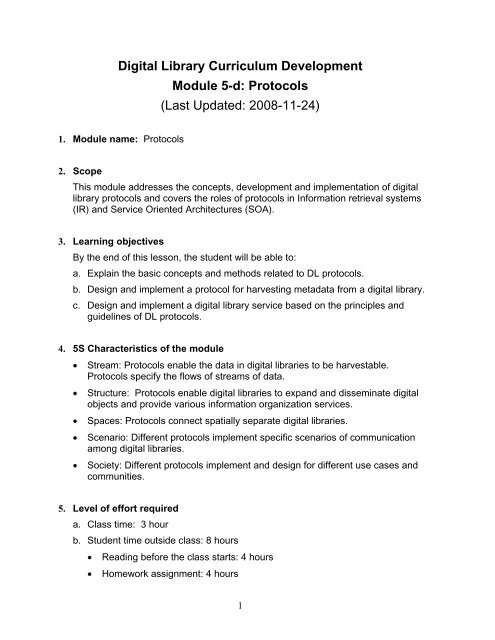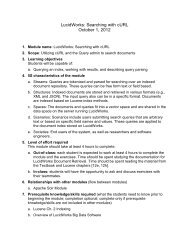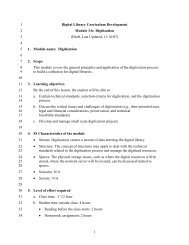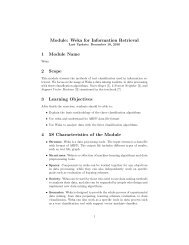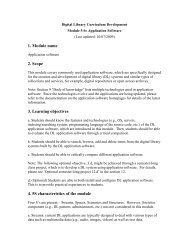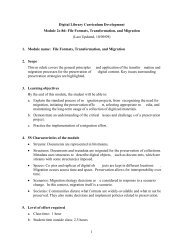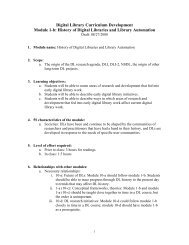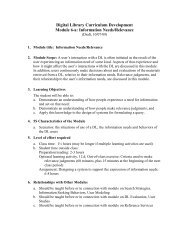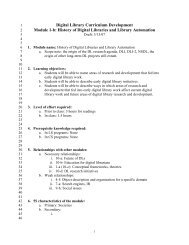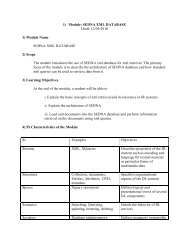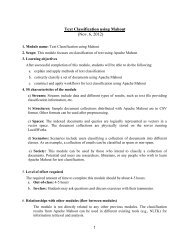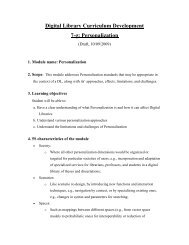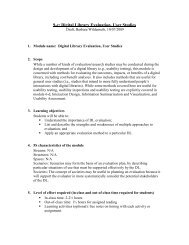Digital Library Curriculum Development Module 5-d: Protocols (Last ...
Digital Library Curriculum Development Module 5-d: Protocols (Last ...
Digital Library Curriculum Development Module 5-d: Protocols (Last ...
Create successful ePaper yourself
Turn your PDF publications into a flip-book with our unique Google optimized e-Paper software.
<strong>Digital</strong> <strong>Library</strong> <strong>Curriculum</strong> <strong>Development</strong><br />
<strong>Module</strong> 5-d: <strong>Protocols</strong><br />
(<strong>Last</strong> Updated: 2008-11-24)<br />
1. <strong>Module</strong> name: <strong>Protocols</strong><br />
2. Scope<br />
This module addresses the concepts, development and implementation of digital<br />
library protocols and covers the roles of protocols in Information retrieval systems<br />
(IR) and Service Oriented Architectures (SOA).<br />
3. Learning objectives<br />
By the end of this lesson, the student will be able to:<br />
a. Explain the basic concepts and methods related to DL protocols.<br />
b. Design and implement a protocol for harvesting metadata from a digital library.<br />
c. Design and implement a digital library service based on the principles and<br />
guidelines of DL protocols.<br />
4. 5S Characteristics of the module<br />
• Stream: <strong>Protocols</strong> enable the data in digital libraries to be harvestable.<br />
<strong>Protocols</strong> specify the flows of streams of data.<br />
• Structure: <strong>Protocols</strong> enable digital libraries to expand and disseminate digital<br />
objects and provide various information organization services.<br />
• Spaces: <strong>Protocols</strong> connect spatially separate digital libraries.<br />
• Scenario: Different protocols implement specific scenarios of communication<br />
among digital libraries.<br />
• Society: Different protocols implement and design for different use cases and<br />
communities.<br />
5. Level of effort required<br />
a. Class time: 3 hour<br />
b. Student time outside class: 8 hours<br />
• Reading before the class starts: 4 hours<br />
• Homework assignment: 4 hours<br />
1
6. Relationships with other modules<br />
a. 4-b: DL protocols are harvesting metadata stored in a digital library. 4-b<br />
should be taught before this module.<br />
b. 5-a: This module should be taught around the same time in the semester.<br />
c. 5-b: This module should be taught around the same time in the semester.<br />
7. Prerequisite knowledge required:<br />
a. Knowledge of client-server, P2P, SOA architectures<br />
b. Understanding of client request and server response<br />
c. Basics of other networking protocols<br />
8. Introductory remedial instruction: Quick overview of software engineering<br />
architectures and basics of simple networking protocols.<br />
9. Body of knowledge<br />
1. Introduction: This module discusses the following digital library protocols:<br />
a. OAI-PMH<br />
b. SOA<br />
c. P2P<br />
d. VIDI<br />
e. Z39.50<br />
f. DLIOP<br />
Later in the module parallel and distributed information retrieval is discussed.<br />
2. Open Archives Initiative Protocol for Metadata Harvesting (OAI-PMH)<br />
a. OAI-PMH version history<br />
i. It is a protocol developed by the Open Archives Initiative.<br />
ii. The Santa Fe Convention led to the first incarnation of the Open<br />
Archives Initiative Protocol for Metadata Harvesting (OAI-PMH).<br />
iii. OAI-PMH 1.0 introduced the unqualified Dublin Core element set<br />
as a baseline for metadata interoperability. OAI-PMH 1.1 was a<br />
revision of the 1.0 specification taking account of changes to the<br />
emerging XML Schema specification. Both v.1.0 and 1.1 were<br />
experimental in nature.<br />
2
iv. OAI-PMH 2.0 is a major revision of the protocol and it is a stable<br />
protocol.<br />
b. Flexible deployment:<br />
i. Multiple service providers can harvest from multiple data providers.<br />
ii. Aggregators can sit between data providers and service providers.<br />
iii. The harvesting approach can be complemented with searching.<br />
c. Main ideas of OAI<br />
i. world-wide consolidation of scholarly archives<br />
ii. free access to the archives<br />
iii. consistent interfaces for archives and service providers<br />
iv. low barrier protocol / effortless implementation<br />
d. Structure model<br />
i. It is a simple protocol based on HTTP and XML.<br />
ii. This protocol is carried within HTTP POST or GET methods.<br />
Figure 1. OAI-PMH structure model<br />
e. Protocol details<br />
i. Records<br />
A record is the metadata of a resource in a specific format. A record<br />
has three parts: a header and metadata, both of which are<br />
mandatory, and an optional about statement.<br />
ii. Datestamps<br />
A datestamp is the date of last modification of a metadata record.<br />
Datestamp is a mandatory characteristic of every item. It has two<br />
3
possible levels of granularity:<br />
YYYY-MM-DD or YYYY-MM-DDThh:mm:ssZ.<br />
iii. Metadata schema<br />
OAI-PMH supports dissemination of multiple metadata formats from<br />
a repository. The properties of metadata formats are:<br />
– ID string to specify the format (metadataPrefix)<br />
– metadata schema URL (XML schema to test validity)<br />
– XML namespace URI (global identifier for metadata format)<br />
iv. Sets<br />
Sets enable a logical partitioning of repositories. They are optional.<br />
v. Request format<br />
Requests must be submitted using the GET or POST methods of<br />
HTTP, and repositories must support both methods. At least one<br />
key=value pair: verb=RequestType must be provided. Additional<br />
key=value pairs depend on the request type.<br />
vi. Response<br />
Responses are formatted as HTTP responses. The content type<br />
must be text/xml. HTTP-based status codes, as distinguished from<br />
OAI-PMH errors, such as 302 (redirect) and 503 (service not<br />
available) may be returned. Compression codes are optional in<br />
OAI-PMH, only identity encoding is mandatory. The response<br />
format must be well-formed XML with markup<br />
vii. Flow control<br />
OAI-PMH supports partitioning. Those managing a repository make<br />
the decisions on partitioning: whether to partition and how.<br />
viii. Errors and exceptions<br />
Repositories must indicate OAI-PMH errors by the inclusion of one<br />
or more error elements.<br />
ix. Request types<br />
There are six different request types:<br />
• Identify<br />
• ListMetadataFormats<br />
• ListSets<br />
• ListIdentifiers<br />
• ListRecords<br />
• GetRecord<br />
f. Implementing protocol<br />
i. Before implementing<br />
• Data Provider:<br />
o Which data do you want to deliver?<br />
o Which Service Providers do you want to provide with<br />
data?<br />
• Service Provider:<br />
o From which Data Providers do you get the metadata?<br />
o Which services do you want to provide, and to whom?<br />
4
ii.<br />
iii.<br />
o What kind of metadata do you want to provide through<br />
your services?<br />
• Other things one also needs to consider:<br />
o Update frequency<br />
o Metadata format<br />
o Subject schema<br />
Data Provider<br />
• Requisites:<br />
o Web server<br />
o Programming interface / API<br />
o Archive identifier / base URL<br />
o Metadata format<br />
o Datestamps for metadata<br />
o Unique identifier for each item<br />
o Logical set hierarchy<br />
o Flow control<br />
• Components:<br />
o Argument Parser validates OAI requests.<br />
o Error Generator creates XML responses with encoded<br />
error messages.<br />
o Database Query / Local Metadata Extraction retrieves<br />
metadata from the repository, according to the required<br />
metadata format.<br />
o XML Generator / Response Creation creates XML<br />
responses with encoded metadata information.<br />
o Flow Control realizes incomplete list sequences for<br />
'larger' repositories. It uses resumption tokens as the<br />
control mechanism.<br />
Service Provider<br />
• Requisites:<br />
o An Internet-connected server<br />
o A database system on equivalent<br />
o A programming environment<br />
• Components and architecture:<br />
o Archive management involves the selection of<br />
repositories to be harvested.<br />
o Request Component creates HTTP requests and sends<br />
them to OAI repositories (Data Provider).<br />
o Scheduler realizes timed and regular retrieval of the<br />
associated archives.<br />
o Flow Control is implemented via resumption tokens,<br />
partitioning of the result list into incomplete sections with<br />
a new request to retrieve more results.<br />
5
o Update Mechanism realizes the consolidation of<br />
metadata which have been harvested earlier (merge old<br />
and new data).<br />
o XML Parser analyses the responses received from the<br />
repositories, with validation using the XML schema, and<br />
transforms the metadata encoded in XML into the internal<br />
data structure.<br />
o Normaliser transforms data in different metadata formats<br />
into a homogenous structure.<br />
o Database receives the output of the normaliser mapping<br />
the XML structure of the metadata into a relational<br />
database that will handle multiple values of elements. An<br />
alternative is to use an XML database.<br />
o Duplication Checker merges identical records from<br />
different data providers.<br />
o Service <strong>Module</strong> provides the actual service to the<br />
'public'. The basis for a service provided is the harvested<br />
and stored records of the associated archives.<br />
3. Service Oriented Architecture (SOA) for <strong>Digital</strong> <strong>Library</strong><br />
a. Simple definition: SOA provides methods for system development and<br />
integration where systems group functionality around business processes<br />
and package these as interoperable services<br />
b. The development of SOA<br />
i. It is an architecture developed with XML and Web Services. It is<br />
commonly built using Web Services standards.<br />
ii. SOA mostly refer to a platform that could realize the concept of<br />
partitioning an enterprise into a series of autonomous services.<br />
c. SOA deployment<br />
i. Run over standard Web protocols: SOA uses XML and HTTP<br />
packaging.<br />
ii. Communication: SOA uses SOAP (Simple Object Access Protocol)<br />
to exchange information, uses WSDL (Web Service Definition<br />
Language) to describe Web Services and uses UDDI (Universal<br />
Description Discovery and Integration) to register Web Services.<br />
d. SOA for digital library<br />
i. Services Technology is widely used in <strong>Digital</strong> Libraries: Fedora,<br />
DSpace and CiteSeer<br />
ii. The requirement for mapping a <strong>Digital</strong> <strong>Library</strong> application/service<br />
into web service:<br />
• An API interface to that application/service<br />
• A standard access layer such as SOAP<br />
• A layer describing the service in a standard fashion encoded<br />
using WSDL<br />
iii. Role of digital library: Service provider.<br />
e. Case Study: Fedora<br />
6
i. Fedora Repository system is a Web Service:<br />
• Access/Search (API-A) and Management (API-M) use web<br />
service<br />
• Service descriptions use WSDL<br />
• Fedora uses both SOAP and HTTP bindings<br />
• Fedora acts as mediator to these services<br />
Figure 2. Fedora Repository System<br />
ii. Fedora Repository Service Interfaces<br />
• Access Service (API-A and API-A-LITE)<br />
o Search - search repository for objects<br />
o Object Reflection - what disseminations can the object<br />
provide?<br />
o Object Dissemination - request a view of the object’s<br />
content<br />
• Management Service (API-M)<br />
o Ingest - XML-encoded object submission<br />
o Create - interactive object creation via API requests<br />
o Maintain - interactive object modification via API requests<br />
o Validate – application of integrity rules to objects<br />
o Identify - generate unique object identifiers<br />
o Security - authentication and access control<br />
o Preserve - automatic content versioning and audit trail<br />
o Export - XML-encoded object formats<br />
7
4. Peer-to-Peer Computing (P2P Computing) for <strong>Digital</strong> <strong>Library</strong><br />
a. Simple definition:<br />
i. Peers act as clients and servers<br />
ii. Peers communicate directly<br />
b. The development of P2P<br />
i. Unstructured P2P (such as Gnutella, Napster) to structured P2P<br />
(such as Pastry, Chord)<br />
ii. P2P used for provide resources: services, for example, storage<br />
services, computational services, streaming media services<br />
c. P2P for <strong>Digital</strong> <strong>Library</strong><br />
i. Main idea<br />
• Build <strong>Digital</strong> <strong>Library</strong> on the P2P structure, use P2P to store<br />
digital objects<br />
• Use P2P to share and route digital documents<br />
ii. Implementation<br />
• Automatically digital documents can be discovered and routed<br />
• Uniform client-level metadata query services that are compatible<br />
with heterogeneous underlying collections<br />
• Sharing of digital documents on P2P structure rather than<br />
storing the documents on a center server<br />
d. Case Study: The ADEPT <strong>Digital</strong> <strong>Library</strong> Architecture<br />
i. ADEPT (Alexandria <strong>Digital</strong> Earth Prototype) architecture<br />
• A framework for building distributed digital libraries of<br />
georeferenced information<br />
• Distributed, heterogeneous, scalable<br />
ii. Objects<br />
• Items: Items are fundamental objects in ADEPT, referring to<br />
digital objects. Items only have identity, no other innate<br />
properties<br />
• Collections: Collections are set of items, information about<br />
individual items is maintained at the collection level<br />
• Libraries: Libraries are set of collections, which expose a single<br />
standard set of interfaces to the collections<br />
iii. ADEPT Collection Discovery Service<br />
• ADEPT takes unstructured P2P mechanism: Reason: simple,<br />
sufficiently manageable and scalable<br />
• ADEPT uses central CDS server and Register server.<br />
• Collection registry polls known library CDS server<br />
8
Figure 3. ADEPT Architecture<br />
5. VIDI<br />
a. Simple definition: A lightweight protocol between visualization systems and<br />
digital libraries.<br />
b. VIDI <strong>Development</strong><br />
i. Extended from OAI Protocol for Metadata Harvesting<br />
ii. Based on <strong>Digital</strong> <strong>Library</strong> likes MARIAN and Visualization Systems<br />
likes Infosphere<br />
c. Protocol<br />
Figure 4. Flow graph of VIDI protocol<br />
i. The labels:<br />
9
• ‘s’ means server-server structure<br />
• ‘c’ means client-server structure<br />
• ‘x’ means in this specific scenario, this command is unused<br />
ii. Four scenarios from left to right<br />
• Most commands in server-server structure<br />
• Least commands in server-server structure<br />
• Most commands in client-server structure<br />
• Least commands in client-server structure<br />
iii. Most commands in client-server structure scenarios<br />
Figure 5. Most commands in client-server<br />
structure scenarios in VIDI protocol<br />
d. VIDI Implementation<br />
i. Use of HTTP Request and Response<br />
• The VIDI protocol requests are expressed as HTTP requests<br />
• HTTP requests may be expressed using either HTTP GET or<br />
POST<br />
ii. Protocol Entities Definitions: Metadata Format, Visdata format,<br />
Transformer, Result Set, Result Record, Result Set Identifier,<br />
Unique Identifier<br />
iii. Dates and Times<br />
• The date used in VIDI protocol is encoded using “Complete<br />
date” variant of ISO8601, the format is YYYY-MM-DD<br />
10
• The time used in VIDI protocol is encoded using the “complete<br />
date plus hours, minutes and seconds” variant of ISO8601, the<br />
format is YYYY-MM-DDThh:mm:ssTZD<br />
iv. VIDI Commands<br />
• Identify: Retrieve system information about a DL or VIS<br />
• ListMetaFormats: Retrieve the metadata format available from a<br />
DL<br />
• ListVisdataFormats: Retrieve the metadata format available<br />
from a VIS<br />
• ListTransformers: Retrieve the transformers that VIS supports in<br />
order to transform the metadata format to the visdata format<br />
• RequestResultSet: Transfer query data<br />
6. Special <strong>Protocols</strong>: Z39.50<br />
a. Introduction:<br />
i. A client server protocol for searching and retrieving information<br />
from remote computer databases<br />
ii. Covered by ANSI/NISO (National Information Standards<br />
Organization) standard Z39.50<br />
iii. Accepted by ISO (International Standards Organization) as<br />
standard 23950<br />
iv. The standard is maintained by the <strong>Library</strong> of Congress (LOC)<br />
v. First version of Z39.50 in 1988, Z39.50 – 1992 (version 2),<br />
Z39.50 – 1995 (version 3)<br />
b. Important components:<br />
i. Target: Implements the abstract database and is a ready made<br />
server module<br />
ii. Gateway: A program that has two interfaces. First, it acts as Origin<br />
to a Z39.50 Target. Second, it handles communication with a client<br />
application. Client protocol may be HTML, Telnet, Z39.50, etc.<br />
Advanced Gateway like the one in the figure below can connect to<br />
several Z39.50 targets for parallel search, serial search, merging of<br />
results. Advanced Gateways can handle several different protocols<br />
on both interfaces SQL, LDAP, HTML, DNS, etc.<br />
iii. Origin: Normally part of graphical client which hides complexity<br />
from the user. It can access several targets simultaneously. There<br />
are clients with a “raw” Origin interface<br />
11
Z39.50 client Z39.50 server<br />
Z39.50<br />
Target<br />
Business<br />
logic<br />
Z39.50<br />
Origin<br />
Web reader<br />
HTTP<br />
server<br />
SQL<br />
client<br />
Proprietary system<br />
Server<br />
for<br />
proprietary<br />
system<br />
LDAP<br />
client<br />
SQL database<br />
LDAP server<br />
Figure 6. Advanced Gateway<br />
Origin<br />
Init request<br />
Version, (ID/password),<br />
option flags,<br />
message sizes,<br />
implementation information<br />
Target<br />
Init response<br />
Result, version,<br />
option flags,<br />
message sizes,<br />
implementation information<br />
Figure 7. Initialization Facility – establishes Z association<br />
12
Origin<br />
Search request<br />
Search type, query,<br />
databases,<br />
result set<br />
limits for small,<br />
medium, large<br />
Target<br />
Search response<br />
Number of records found,<br />
number of records attached,<br />
status information,<br />
(records)<br />
Figure 8. Search Facility<br />
Origin<br />
Present request<br />
Number of records,<br />
starting point,<br />
result set<br />
Target<br />
Present response<br />
Number of returned<br />
status,<br />
(records)<br />
Figure 9. Retrieval Facility<br />
13
Origin<br />
Delete request<br />
list of result sets<br />
to delete<br />
Target<br />
Delete response<br />
status<br />
Origin<br />
Figure 10. Result-set-delete Facility<br />
Request<br />
Target<br />
Access control response<br />
Security-challenge<br />
Access control request<br />
Security-challenge-response<br />
Response<br />
Figure 11. Access Control Facility<br />
14
Origin<br />
Sort request<br />
result set to sort,<br />
sorted result set,<br />
sort directives<br />
Target<br />
Sort response<br />
status<br />
Figure 12. Sort Facility<br />
Origin<br />
Scan request<br />
database, term<br />
list, starting point,<br />
number of terms,<br />
(step size)<br />
Target<br />
Scan response<br />
status<br />
number of elements<br />
(elements)<br />
Figure 13. Browse Facility<br />
7. Special <strong>Protocols</strong>: Stanford’s <strong>Digital</strong> <strong>Library</strong> Interoperation Protocol (DLIOP)<br />
a. Stanford <strong>Digital</strong> <strong>Library</strong> test bed<br />
i. Stanford <strong>Digital</strong> <strong>Library</strong> test bed was a platform for experimentation<br />
with interoperation among online services.<br />
ii. The figure 13 shows the InfoBus, central to the architecture of the<br />
Stanford test bed. It is based on a hardware bus metaphor to<br />
15
suggest that services, repositories, and clients are 'plugged in', and<br />
interoperate by taking advantage of interoperability mechanisms<br />
built into the testbed.<br />
iii. DLIOP is an asynchronous protocol, providing robustness in the<br />
face of network or server outages<br />
iv. The approach is to use distributed objects to allow integrated<br />
access to heterogeneous service across networks.<br />
v. The distributed approach allows the interaction of processes on<br />
different machines, with different architectures, implemented in<br />
different languages.<br />
vi. It uses CORBA to provide communication between remote<br />
processes. Xerox PARC’s ILU, a free implementation of a CORBA<br />
superset, is used.<br />
Figure 14. InfoBus<br />
b. Z39.50 Interoperability Example of InfoBus: Top part of Figure 14 shows<br />
how a Z39.50 client communicates with other services (can be Z39.50 or any<br />
other Service). Bottom part of Figure 14 shows how non-Z39.50 clients consume<br />
services provided by a Z39.50 Service. The rounded rectangles in the figure are<br />
parts interfacing with the InfoBus communicating via DLIOP to provide the<br />
interoperable framework.<br />
16
Z39.50<br />
client<br />
Z39.50 Z-Server DLIOP<br />
Client<br />
Remote<br />
Service<br />
Proxy<br />
Service<br />
Z39.50<br />
Server<br />
Interface<br />
Z39.50<br />
Client<br />
Interface<br />
Client<br />
Program<br />
DLIOP<br />
RSP<br />
Z39.50<br />
Z-Client<br />
Z39.50<br />
Service<br />
Figure 15. Z39.50 Interoperability Example of InfoBus<br />
8. Parallel and Distributed Information Retrieval<br />
a. Motivation<br />
i. Exponential growth in size of online scientific data.<br />
ii. Managing the size and growth of data demands scalable and<br />
multitasking algorithms.<br />
b. Requirements for Distributed IR <strong>Protocols</strong><br />
i. Enable retrieval of data from digital collections that are<br />
geographically separated.<br />
ii. Provide methods for linking and accessing heterogeneous<br />
collections of scientific data.<br />
c. Features of Parallel IR<br />
i. Computation model divides the main task into sub-tasks and<br />
executes the sub-tasks in parallel.<br />
ii. Sub-tasks generally run on homogeneous systems and each<br />
system works on the same problem.<br />
iii. Parallel IR uses shared memory models.<br />
iv. Parallel IR broadcasts every request to every process.<br />
v. Main objective is to achieve speed-up.<br />
d. Features of Distributed IR<br />
i. Like Parallel IR, computation model in Distributed IR divides the<br />
main task into sub-tasks and executes the sub-tasks in parallel.<br />
17
ii. Distributed IR sub-tasks are run on different processing units<br />
where inter-process communication is via network protocols.<br />
iii. Sub-tasks may run on heterogeneous systems.<br />
iv. Distributed IR employs a procedure to select a subset of<br />
processes to broadcast a request.<br />
v. Main objectives in Distributed IR are to achieve scalability and<br />
availability and speed, but may not be efficient.<br />
e. Case Study on Parallel IR<br />
i. Paper on Inverted File Partitioning Schemes in Multiple Disk<br />
Systems (IEEE transactions on Parallel and distributed systems,<br />
Vol 6, Feb 1995) by Byeong-Soo Jeong and Edward Omiecinski.<br />
ii. Paper discusses two schemes for Parallel IR implementation.<br />
iii. Goal of the paper is to reduce average response time by<br />
partitioning the inverted file.<br />
iv. The paper identifies I/O time as a major cost factor in IR system.<br />
v. It exploits the potential of I/O parallelism and balances I/O workload<br />
for better response time by partitioning and distributing<br />
files.<br />
vi. The paper discusses two partitioning schemes: based on termid<br />
and based on document-id for inverted file systems.<br />
f. Case Study on Distributed IR<br />
i. Paper on Methodologies for Distributed Information<br />
Retrieval (18 th international conference on Distributed<br />
Computing Systems – 1998) by Alister Moffat, Justin Zobel,<br />
Owen De Kretser and Tim Shimmin.<br />
ii. This paper discusses three different methodologies for<br />
Distributed IR and compares their effectiveness, efficiency and<br />
response time.<br />
Librarian<br />
Index<br />
User query<br />
Receptionist<br />
User-Interface<br />
Sub-Collection<br />
Result Global information Librarian<br />
about Librarians<br />
Index<br />
Sub-Collection<br />
18
Fig16. Distributed IR Model described in the paper<br />
iii. Three different methodologies are defined based on the global<br />
information stored at the receptionist.<br />
• Central Nothing – CN<br />
The only global information maintained by the<br />
receptionist is a list of librarians.<br />
• Central Vocabulary – CV<br />
Global information stored by the receptionist is the<br />
vocabularies of the sub-collections.<br />
• Central Index – CI<br />
Receptionist has full access to the indexes of subcollections.<br />
iv. Comparison between three different methodologies for<br />
Distributed IR (advantages and disadvantages).<br />
10. Resources<br />
a. Required readings for students<br />
i. Carl Lagoze, Herbert Van de Sompel. The Open Archives Initiative:<br />
Building a Low-Barrier Interoperability Framework. JCDL, pp.54-62, First<br />
ACM/IEEE-CS Joint Conference on <strong>Digital</strong> Libraries (JCDL'01), 2001.<br />
http://www.openarchives.org/documents/jcdl2001-oai.pdf<br />
ii. Byeong-Soo Jeong; Omiecinski, E. Inverted File Partitioning Schemes in<br />
Multiple Disk Systems. Parallel and Distributed Systems, IEEE<br />
Transactions on Volume 6, Issue 2, Feb. 1995 Page(s):142 - 153 <strong>Digital</strong><br />
Object Identifier 10.1109/71.342125.<br />
http://csdl.computer.org/comp/trans/td/1995/02/l0142abs.htm<br />
iii. De Kretser, O.; Moffat, A.; Shimmin, T.; Zobel, J. Methodologies for<br />
Distributed Information Retrieval. Distributed Computing Systems, 1998.<br />
Proceedings. 18th International Conference on<br />
26-29 May 1998 Page(s):66 – 73. <strong>Digital</strong> Object Identifier<br />
10.1109/ICDCS.1998.679488. http://csdl.computer.org/comp/proceedings<br />
/icdcs/1998/8292/00/82920066abs.htm<br />
b. Recommended readings for students<br />
i. Metadata Preparation for the Gateway to Educational Materials.<br />
http://www.thegateway.org/about/documentation/metadatapreparation/met<br />
aprep/<br />
ii. OAI for beginners – the Open Archives forum online tutorial<br />
http://www.oaforum.org/tutorial/english/intro.htm<br />
iii. PREMIS Data Dictionary for Preservation Metadata.<br />
http://www.loc.gov/standards/premis/v2/premis-2-0.pdf<br />
19
iv. Suleman, H., and Fox, E. A. Beyond Harvesting: <strong>Digital</strong> <strong>Library</strong><br />
Components as OAI Extensions, Technical Report, Department of<br />
Computer Science, Virginia Tech, 2002.<br />
http://eprints.cs.vt.edu:8000/archive/00000625/<br />
v. Suleman, H. Open <strong>Digital</strong> Libraries, Dissertation, Department of Computer<br />
Science, Virginia Tech, 2002. http://scholar.lib.vt.edu/theses/available/etd-<br />
11222002-155624/<br />
vi. Carl Lagoze, Y Payette, Edwin Shin, Chris Wilper, Fedora: An Architecture<br />
for Complex Objects and their Relationships, International Journal on<br />
<strong>Digital</strong> Libraries, Vol. V6, No. 2. (April 2006), pp. 124-138.<br />
vii. Yves Petinot, C. Lee Giles, Vivek Bhatnagar, Pradeep B. Teregowda, Hui<br />
Han, Isaac Councill, A Service-Oriented Architecture for <strong>Digital</strong> Libraries<br />
(2004), In Proc International Conference on Service Oriented Computing,<br />
http://www.personal.psu.edu/staff/i/g/igc2/papers/petinot04service.pdf<br />
viii. Wang, Jun. VIDI: A Lightweight Protocol Between Visualization Tools and<br />
<strong>Digital</strong> Libraries, Master’s Thesis, Virginia Tech (May 2002).<br />
http://citeseerx.ist.psu.edu/viewdoc/summary?doi=10.1.1.4.6318<br />
ix. B Ahlborn, W Nejdl, W Siberski, OAI-P2P: A Peer-to-Peer Network for<br />
Open Archives, 2002 International Conference on Parallel Processing.<br />
x. M Bender, S Michel, C Zimmer, G Weikum, Towards Collaborative Search<br />
in <strong>Digital</strong> Libraries Using Peer-to-Peer Technology, In DELOS<br />
Workshop: <strong>Digital</strong>. <strong>Library</strong> Architectures, pages 61–72, 2004.<br />
xi. I Podnar, T Luu, M Rajman, F Klemm, K Aberer, A Peer-to-<br />
Peer Architecture for Information Retrieval Across <strong>Digital</strong><br />
<strong>Library</strong> Collections, LECTURE NOTES IN COMPUTER SCIENCE, 2006.<br />
http://globalcomputing.epfl.ch/alvis/research/publications/2006ECDL-<br />
Podnar.pdf<br />
xii. Greg Janee, James Frew, The ADEPT digital library architecture,<br />
Proceedings of the 2nd ACM/IEEE-CS joint conference on <strong>Digital</strong> libraries,<br />
2002, Pages: 342 – 350.<br />
http://portal.acm.org/citation.cfm?id=544220.544306<br />
xiii. Gerard Salton and Chris Buckley, Parallel Text Search Methods- paper by<br />
Salton and Buckley, Technical Report: TR87-828, 1987.<br />
http://portal.acm.org/citation.cfm?id=866232&coll=GUIDE&dl=GUIDE&CFI<br />
D=11874001&CFTOKEN=41172959#<br />
xiv. Robert Kahn, Robert Wilensky, A framework for distributed digital object<br />
services, International Journal on <strong>Digital</strong> Libraries, Volume 6, Issue 2,<br />
2006, Pages: 115 – 123.<br />
http://portal.acm.org/citation.cfm?id=1124646.1124650&coll=GUIDE&dl=G<br />
UIDE&CFID=11874001&CFTOKEN=41172959<br />
xv. Ray R. Larson, Distributed IR for <strong>Digital</strong> Libraries, 2003, Pages: 487-498.<br />
http://www.springerlink.com/content/eujdc8265v8f55a9/fulltext.pdf<br />
20
xvi. International Standard Maintenance Agency Z39.50<br />
http://www.loc.gov/z3950/agency/<br />
xvii. Stanford <strong>Digital</strong> <strong>Library</strong> Testbed <strong>Development</strong><br />
http://dbpubs.stanford.edu:8091/~testbed/<br />
xviii. Andreas Paepcke, Summary of Stanford’s <strong>Digital</strong> <strong>Library</strong> Testbed Design<br />
and Status, 1996. http://www.dlib.org/dlib/july96/stanford/07paepcke.html<br />
xix. University of Michigan <strong>Digital</strong> <strong>Library</strong> Project<br />
http://www.dlib.org/dlib/july96/07atkins.html<br />
c. Suggested readings for instructors<br />
i. Van de Sompel, H., and Lagoze, C. The Open Archives Initiative Protocol<br />
for Metadata Harvesting. Protocol Version 2.0 of 2002-06-14, Document<br />
Version 2004/10/12T15:31:00Z<br />
http://www.openarchives.org/OAI/2.0/openarchivesprotocol.htm<br />
11. Concept map (created by students)<br />
Note: IHMC Cmap Tools is an open source client tool to create concept maps.<br />
CmapServer enables the users to collaborate and share concept maps anywhere on<br />
the internet. Both software can be downloaded freely for educational purposes from<br />
http://cmap.ihmc.us/download/index.php<br />
12. Exercises / Learning activities<br />
• Homework assignment:<br />
o Form student groups<br />
• Evaluate the interoperability of DL services using the<br />
Stanford and University of Michigan <strong>Digital</strong> <strong>Library</strong> Testbeds<br />
o Peer-to-Peer architecture is widely used to store digital objects. So,<br />
considering a peer-to-peer structure which enables a digital object<br />
repository, such as ADEPT, what kind of digital library service<br />
should be implemented?<br />
• In-class activities:<br />
o In class, break students into groups of 3~4<br />
• Each group discusses what kind of services their digital<br />
library should provided. Does the digital library act as data<br />
provider or service provider?<br />
• Discusses what kind of metadata format and subject schema<br />
will provide, and what update frequency.<br />
21
• Discusses choice of kind of digital library architecture and<br />
the components to construct these services.<br />
• Discusses what kind of protocols will be implemented and<br />
why?<br />
• The syntax of the underlying database is abstracted in<br />
Z39.50, what are the advantages and disadvantages of that?<br />
13. Evaluation of learning achievement<br />
In their answers to the discussion questions, students demonstrate an<br />
understanding of<br />
• Different DL protocols<br />
• What role does DL protocols acted in DL architecture?<br />
• What the requirement for IR protocols?<br />
Evaluate the DL harvesting/providing service which student created.<br />
14. Glossary<br />
o Dublin Core (DC): A shorthand term for the Dublin Core Metadata Element<br />
Set, the primary work of the Dublin Core Metadata Initiative (DCMI); a set of<br />
metadata elements intended to be generic and universally useful for object<br />
description.<br />
o Interoperability: The ability of two or more systems or components to<br />
exchange information and to use the information that has been exchanged.<br />
o Metadata: Data about data; structured description of information objects; used<br />
to aid the understanding, administration, and use of information objects.<br />
o Resource discovery: Identifying previously unidentified (to the user) data<br />
objects<br />
o CORBA: The Common Object Requesting Broker Architecture is a standard<br />
defined by the Object Management Group (OMG) that enables software<br />
components written in multiple computer languages and running on multiple<br />
computers to work together.<br />
15. Additional useful links<br />
None<br />
16. Contributors<br />
Ajeet Singh (Virginia Tech, developer), Yinlin Chen (Virginia Tech, developer),<br />
Srinivasa Santhanam (Virginia Tech, developer), Weihua Zhu (Virginia Tech,<br />
developer), Edward A. Fox (Virginia Tech, evaluator)<br />
22


